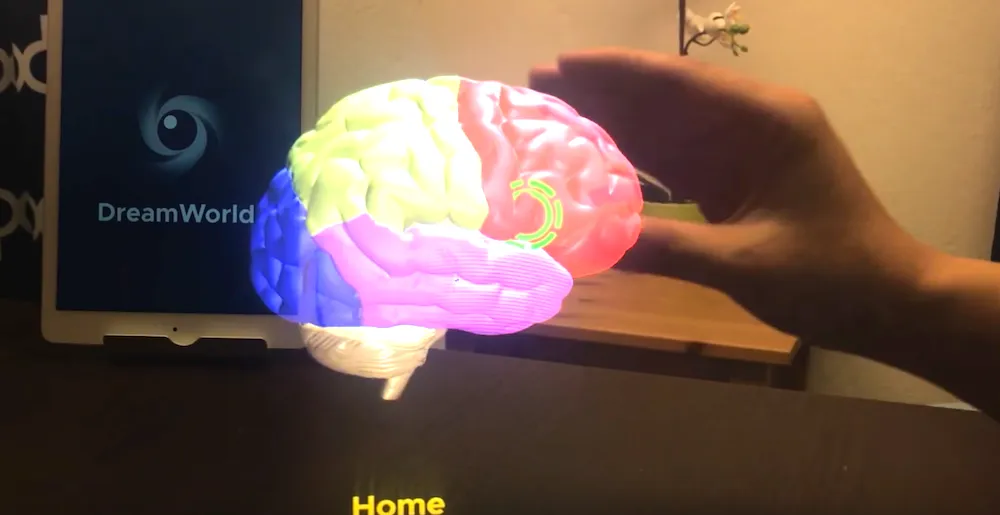The AR market is currently populated by companies that offer nice results at very high costs. A new Chinese startup, however, is prototyping a new solution that is intended to be comparable in performance to the big players for a fraction of the price.
Dreamworld Vision has 10 employees say raised only $2 million in funding — a pittance when compared to the cash that the big name AR companies like Magic Leap, Microsoft and Meta have. And yet, despite these limited resources, the Dreamworld team created something aimed at rattling the cages of its biggest competitors: a pair of AR glasses with abilities that compare to these $1000 + units that will be sold for less than $350.
What is it?
Dreamworld’s inaugural AR headset is being called the Dreamworld Glass. UploadVR recently had the chance to try it out at the company’s offices but we were not allowed to take photos, nor did representatives provide us with photographs of the unit for this story.
The Glass we demoed came in two form factors. The first was a smaller, lighter model that was used primarily to show off the headset’s large field of view and basic head tracking. The second was significantly larger and was outfitted with “over the counter” depth sensors and cameras to achieve basic positional tracking. A Dreamworld representative explained that the final version will be comprised of custom-designed components and will be similar to the form factor of the smaller unit.

Both headsets seemed smaller and lighter than either the Meta 2 or Microsoft HoloLens. The headsets connected to an android smartphone via a USB-C connector.
What can it do?
During the demo we saw the Glass in action during three simple experiences. The first was a basic content selection menu.
Three small yellow squares were brought in front of our eyes and we could select whichever one we wanted by holding our hand physically up to it and making a gesture similar to a shadow puppet duck. this is the “click” gesture for the Dreamworld UI.
From the selection screen we could chose to either launch an educational app that would project a holographic model of the human brain, or a video player.
The brain experience was simple and involved mostly clicking on the different hemispheres of the brain to assemble it into a whole and see how they all fit together. The brain was anchored in space, meaning if I turned my head it would vanish until I returned my gaze to where it existed digitally.
The video player brought up a suite of panels, each representing a different video. These were anchored in place as well. I could click onto each and it would begin to play in a much larger panel that was locked to my gaze to move with my head. This was also where the Dreamworld representative showed me the “VR mode” which was basically holding a black piece of cardboard in front of the headset to block out light.
Does it work?
Yes and no. On certain fronts the Glass was more impressive than its big name rivals, but there was one area where it really struggled: Tracking.
To date, no other AR headset has managed to touch Microsoft when it comes to inside-out wireless AR tracking. The Dreamworld demo we tried on the SLAM model was jittery and glitch-prone throughout. It is worth noting that after the demo we received an email saying that the team had discovered and fixed certain bugs and programming issues that were adversely affecting the Glass’ performance during our time with it. This makes it tough to say how well a final version of the Glass could work, but at this point all we can say from experience is that the positional tracking was far from successful.
Tracking problems aside, the Glass’ FOV was legitimately impressive. So many AR headsets suffer from their small fields of view — placing a small rectangle of space upon which the world can be enhanced. On the Glass, however, these borders seemed to be just outside my peripheral vision. This meant that the world truly seemed to be littered with brains and video screens rather than these only existing in a very small portion of my vision.
The Glass seems to use a Meta-esque optics system that places the screens at an angle above the lenses. The light from the screens then reflects down onto the lenses to create AR overlays in a wide FOV effect.
The basic head-tracking-only model I tried actually worked better than the larger one and provided an experience in terms of FOV and resolution that was honestly exciting for a headset that is aiming to ship at this price.
When will it launch? What will it cost?
According to Dreamworld, the Glass will begin shipping in limited supply and in limited markets this holiday season. This seems quite ambitious for a product that is reportedly just now finishing up its industrial design for manufacturers. That’s the timeline they stuck with, however.
A final price has not been set but Dreamworld says that it will be under $350. For reference, the HoloLens developer kit that is currently available costs $3000 and the Meta 2 can be pre-ordered for $950.
Maintaining that low price point is a key goal for Dreamworld which views keeping things cheap and simple will be essential to driving its success.
The Glass will be officially unveiled at CES Asia which kicks off in June.



























